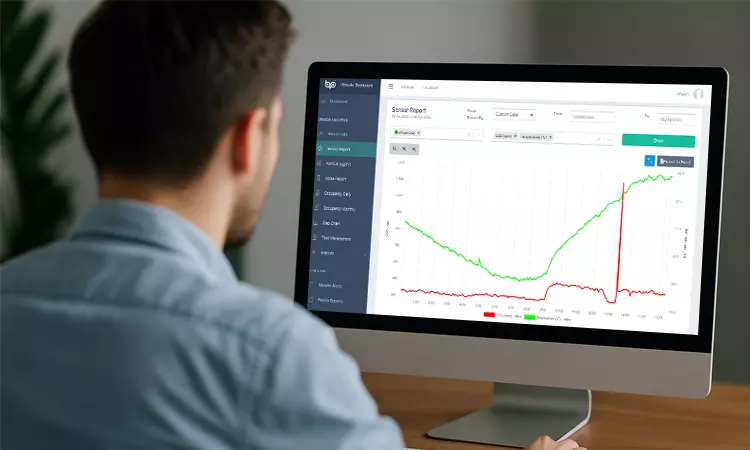The Role of Data Analytics in Predicting Indoor Air Quality Trends
Indoor air quality (IAQ) is a dynamic factor influenced by changing occupancy, outdoor pollution levels, ventilation performance, weather, and daily routines. Treating IAQ as static often leads to unexpected issues such as CO2 spikes during meetings or particulate matter surges after cleaning activities. Instead of waiting for problems to occur, predictive analytics enables facility managers to forecast air quality trends and take action before comfort, health, or compliance is compromised. With solutions like the HibouAir Desktop Air Quality Monitoring Solution and HibouAir Cloud Platform, organizations can easily collect and analyze the data required for accurate predictions.
Why Prediction Beats Reaction
Predictive analytics allows managers to anticipate poor air quality instead of responding after conditions deteriorate. For instance, forecasting CO2 and particulate matter trends helps prevent headaches, fatigue, and allergy flare-ups before they occur. This proactive approach also enables targeted HVAC use, increasing airflow only when forecasts indicate upcoming deterioration—saving energy without sacrificing comfort. From a compliance perspective, predictive models provide traceable, time-series forecasts and anomaly reports that simplify ESG reporting and audits. Businesses adopting this strategy, particularly those using advanced monitoring tools like the HibouAir Standalone Device, can maintain high air quality while optimizing operational efficiency.
The Data That Makes IAQ Predictable
Accurate IAQ prediction depends on high-quality, multi-parameter data. Core environmental indicators—CO2 levels, particulate matter concentrations (PM1, PM2.5, PM10), temperature, humidity, volatile organic compounds (VOCs), pressure, and even ambient noise—provide the foundation. Contextual inputs such as room occupancy schedules, ventilation settings, and cleaning activities further refine model accuracy. The ability to collect and integrate all these inputs into one platform is what makes HibouAir’s Analytical Dashboard a vital tool for predictive analysis.
Turning Predictions into Action
Once forecasts are in place, facility managers can use them to guide interventions. For example, ventilation can be pre-emptively increased before predicted CO₂ spikes, reducing energy consumption compared to continuous operation. Cleaning schedules can be adjusted to times when forecasts indicate better particulate dispersion. In facilities with sensitive equipment or artifacts—such as museums—these predictive insights can be combined with specialized monitoring approaches discussed in our article on Monitoring Air Quality in Museums. Predictive maintenance is also possible; if residual trends suggest filtration efficiency is declining, maintenance can be scheduled before air quality drops.
How HibouAir Makes This Possible
HibouAir offers a complete ecosystem for predictive IAQ management. Its multi-sensor devices measure CO2, particulates, VOCs, temperature, humidity, noise, and more with high precision, delivering the rich datasets predictive models require. The HibouAir Analytical Dashboard provides real-time and historical visualization to identify patterns and validate forecasts. The HibouAir Portal offers fleet-wide monitoring and analysis, making it easy to compare multiple sites and correlate indoor conditions with outdoor influences. Features like historical data visualization, real-time alerts, automated weekly reports, and CSV export ensure that both daily operations and long-term analysis are covered.
A Practical Workflow
A straightforward way to begin is by deploying HibouAir devices across all relevant spaces, tagging them with metadata such as capacity, function, and ventilation type. After two to four weeks of baseline data collection, patterns can be established using the dashboard, with anomalies cleaned from the dataset. From there, forecasting models can be implemented, starting with simpler statistical approaches and advancing to machine learning as the dataset grows. Predictions can be tied to automated alerts via the HibouAir Portal, enabling interventions such as pre-ventilation before predicted peaks. Weekly and monthly reports provide stakeholders with evidence of both compliance and improvement.
Tracking Success
Measuring success in predictive IAQ management involves tracking key performance indicators like time spent within target thresholds, the number of predicted high-risk hours, and the precision of alerts. The HibouAir Cloud Enterprise Solution makes it simple to track and visualize these metrics across a portfolio of buildings. Over time, improved IAQ stability and reduced intervention costs prove the value of predictive analytics.
Privacy and Data Governance
Since IAQ data can imply occupancy levels, HibouAir ensures that monitoring remains privacy-conscious by aggregating readings at the zone level and providing secure cloud access via HibouAir Cloud Lite or Enterprise platforms.
The future of IAQ prediction lies in integration—linking HibouAir forecasts with building management systems for fully automated ventilation control, incorporating weather forecasts to anticipate infiltration effects, and applying root-cause analysis when anomalies are detected. As explored in our guide on Improving Indoor Air Quality in Offices, such predictive strategies enhance comfort, reduce costs, and improve compliance. HibouAir’s connected ecosystem ensures that organizations of any size can adopt predictive analytics without the need for complex, custom-built systems.

